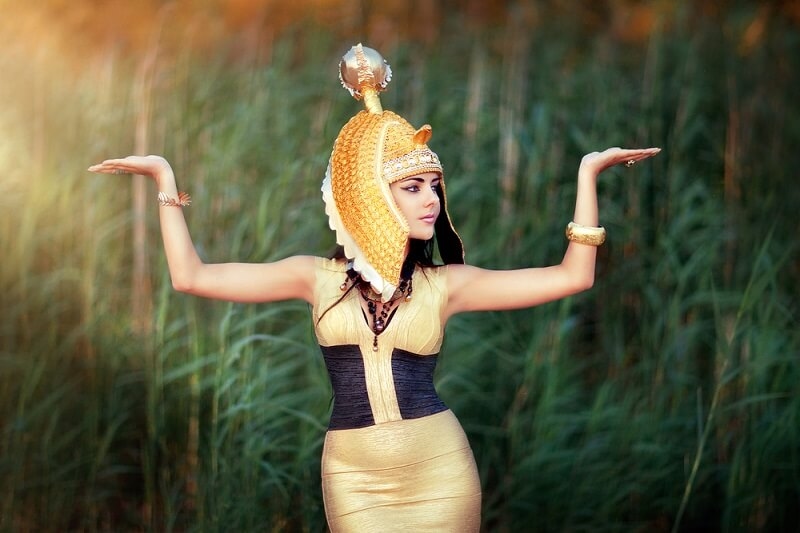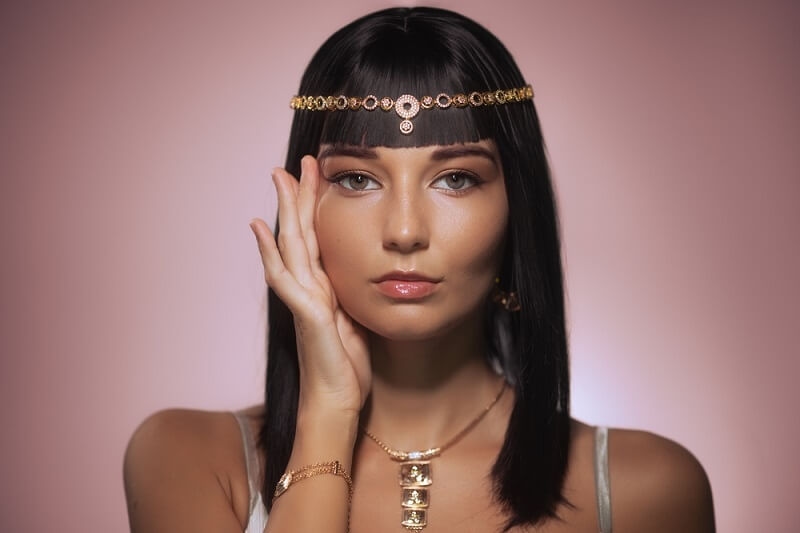
Ancient Egypt has always attracted historians, archaeologists, and enthusiasts to its majesty and mystery. Among all its treasures and artifacts, the Egyptian gold headpieces stand as the most impressive examples of artistry, craftsmanship, and cultural importance of the ancient civilization. Intricate ornaments were not merely accessories but significant symbols of power, divinity, and social hierarchy. Gold headpieces have become the embodiment of the sophistication in ancient Egyptian society, from rulers who donned them to artisans painstakingly making them.
The importance of Egyptian gold headpieces has an intrinsic tie to the cultural and religious practices. Gold, for one, is known as the flesh of the gods. It is therefore the best material to use for items of spiritual and earthly significance. It symbolized eternity and heavenly connection due to its luminous and indestructible nature and was therefore a required element in most royal accessories. These headgears were meant for the great pharaohs, queens, and various high-ranking individuals. They served more as status signs and protective amulets. Detailed designs indicated which position the individual held in the society and by extension in divine order.
We begin this blog with the history, symbolism, and artistry of Egyptian gold headpieces. This blog will trace out how these icons were made, which motifs and themes were featured, and how they influence the modern world in such a significant way, fashion-wise, and jewelry design-wise.
The tradition of decorating the head with gold can be traced back to the early dynasties of Egypt. Archaeological findings show that gold headpieces were part of the royal outfit for ceremonies, religious ceremonies, and public appearances. During the Old Kingdom (c. 2686-2181 BCE), more advanced gold adornments began to surface, but designs improved throughout the Middle and New Kingdoms.
The gods on earth: the pharaohs: wore gold headpieces symbolizing their heavenly right to the throne. Highly often included are pieces of the uraeus, a rearing cobra symbolizing protection and authority. The reign of pharaohs like Tutankhamun and Cleopatra saw a great increase in sophisticated complexity along with beauty, with gold combined with other precious materials like lapis lazuli, turquoise, and carnelian.

Egyptian gold headpieces were very symbolic. The material, motifs, and designs chosen had to depict the wearer's connection to the divine and the position they held in society. For example, the uraeus cobra is very common on headpieces, it symbolizes the Wadjet goddess and is a protection and sovereignty sign. The vulture motifs that are connected to the goddess Nekhbet were maternal protection signs and queens mostly wore them.
Some of the most recurring motifs were the sun disk, representing the sun god Ra, and lotus flowers that symbolized rebirth and eternal life. Such use of symbols for such ornaments was not only aesthetic but also added to the symbolic values of these headpieces. As such, these headpieces were not only for decoration but served as powerful communicative tools to identify the wearer, their beliefs, and their relationship with the divine.
The making of Egyptian gold headdresses demanded brilliant skill and a deep sense of intricacy. Some of the earlier techniques used for hammering and engraving alongside filigree were used on raw gold and transformed into remarkable works of beauty. The gold was always mixed with different other materials and created color designs that shine vividly to express the greatness of wearing it.
Artisans have used molds and dies to make gold sheets shaped into desired products, which then were ornamented with elaborate designs and symbols. Techniques of enameling and inlaying with bright gemstones and colored glasses were also much in use, and each item was crafted into precision with minute details conveying the message of power and divinity.
The headpieces were made from gold sourced from Nubia, which was known to have very good gold deposits. Mining and processing such amounts of gold was indeed an expensive venture that came with a lot of hard work, making the value attached to it in society significant. Only the richest and most influential could own such wealthy attires, but again, that made them exclusive.
In the old Egyptian world, hair had immense significance and played a pivotal role. Hence, the golden headpieces are also aimed at going with elaborately styled and braided wigs. For upper-class individuals of both genders, hair adornment in the form of gold decorations, such as diadems, circlets, and hairpins, displayed wealth and prestige.
Human hair and plant fibers comprise the wigs worn by the pharaohs and queens and, in more intricate braids and curls, create the ornate hairstyles. It was to the headpieces in gold that they attached these wigs for the appearance of continuity, a kind of harmonious integration. A fusion of such grandiose wigs and ornaments of gold evoked an unparalleled spectacle to the impression of being a ruling authority figure and object of reverence.
The use of gold headpieces with hair fashion emphasizes the role of personal appearance in ancient Egypt. Every detail, from the hairstyle to the choice of jewelry, was taken into consideration to project an image of power, elegance, and divinity.
Beyond their physical beauty, the Egyptian gold headpieces were a symbolic ornament that carried deep significance. They symbolized specific gods or goddesses, underlining the affinity of the wearer with the divine beings. For instance, the headdress of the queens was that of the vulture, which highlighted their role of being the mother and protector of the nation besides their association with the goddess Nekhbet.
Headpieces were used in funerary contexts; they were placed on the heads of mummies so that the deceased could safely make it to the afterlife. The famous mask of Tutankhamun, gold with intricate inlays, is a prime example of the symbolic importance of such adornments. Such pieces are believed to protect the soul and guide it through the challenges of the underworld.
Egyptian gold headpieces have inspired modern jewelry and fashion design. Their timeless elegance and intricate craftsmanship have made them enduring symbols of luxury and sophistication. Modern designers often draw inspiration from ancient motifs, such as lotus flowers, cobras, and sun disks, in their creations.
Modern society, such as through the Egyptian Museum in Cairo and the British Museum in London, continues to show the breathtaking exhibits for which humanity appreciates these beautiful pieces. It goes without saying that this heritage of Egyptian gold headpieces shows that there will never be an end to antique jewelry since its power and elegance stand across cultures and eras.
Egyptian gold headpieces are beyond mere artifacts, as they form windows into the vast cultural, religious, and artistic traditions of ancient Egypt. Symbols of the great finesse and elegance of one of history's finest civilizations, it is through their unmatched craftsmanship these accessories are elaborately designed along with symbolic themes, representing spiritual significance, defining, in every way, Egypt's artistic superiority and ingenuity.
These symbolic adornments are indelibly etched into our collective minds and remind us of the continued quest of humanity to express identity, status, and belief through art. Then, through these treasures, we are able to know better the value systems and aspirations of the ancient Egyptians to their posterity. These headpieces not only remind us of a glorious past but also strike our imagination with the connection people have had to art and symbolism throughout cultures.
This content was created by AI